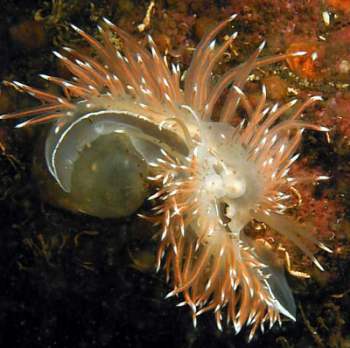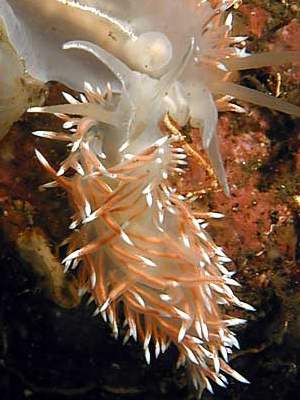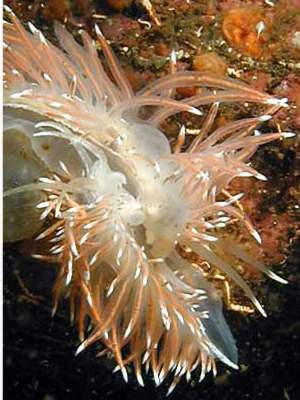Flabellina lineata at Loch Etive, Scotland
August 16, 2003
From: Jim Anderson

Dear Bill,
Here are some images of Flabellina lineata taken during a recent dive, 10 August 2003, and shows a pair mating. The dive was at Rubh'aird Phlacaig on the north shore of Loch Etive on the west coast of Scotland.
The animals were found at 12.2 metres and the water temp was 12 deg C. The larger animal approx. 50mm long which puts it at the top end of the animals size range I believe. This pair were found with along with several others (approx. 12 over 2 sq. M?) with other isolated specimens and small groups of 2 or 3 encountered at different depths (10-20 m) during this and the preceding dive that day. All of the animals were big (40 - 50mm), something I have observed before with this species in this Loch on previous 10 dives over the last 3 years, but not elsewhere. There usual size range is 15 - 25mm.
Loch Etive is unusual in that is a long narrow loch with 4 deep basins separated by narrow shallow sills leading to low levels of salinity, in the surface layers where I've been, and low light levels due to the peat washed into the loch from the surrounding hills. The site where these animals were located is approx. 16 nautical miles from the outermost sill near the sea and the basin drops to over 100 m depth - the sill between it and the next one nearer to the sea is only 6 m deep. There will be a low turnover of water and larvae in and out of these basins and I wonder whether the large size could be a local variation as a consequence. I know that my limited observations are hardly scientific but I keep coming back to the question why so many big animals in this inner basin and not elsewhere. It might interest someone with the skills and energy to investigate further or am I just getting carried away after what was a very lucky and exciting observation of the animals mating behaviour?
Kind regards,
Jim Anderson
JAnder4454@aol.com


Dear Jim,
Thanks for these interesting observations. If the large animals represent a 'genetically distinct' population you might expect they would not mate until they reached a larger than normal size. Your photo showing the small animal mating with the large animal suggests otherwise. My feeling with these large animals is that they are either eating and growing much faster than normal - due to an overabundance of food, or else they are living much longer than normal - perhaps due to a constant availability of food. Perhaps the nature of the fjord-like environment is conducive to lush and reliable growth of the hydroids this species eats throughout the year?
But as you say these things need proper investigation. A study of populations in these Scottish fjords would indeed be an interesting and hopefully rewarding study for a student.
Best wishes,
Bill Rudman
Related messages
-
Re: Flabellina lineata from France
From: Dominique Horst, March 6, 2008 -
Flabellina lineata from Scotland
From: Jim Anderson, May 25, 2005 -
Flabellina lineata from France
From: Peter H. van Bragt , September 24, 2000
